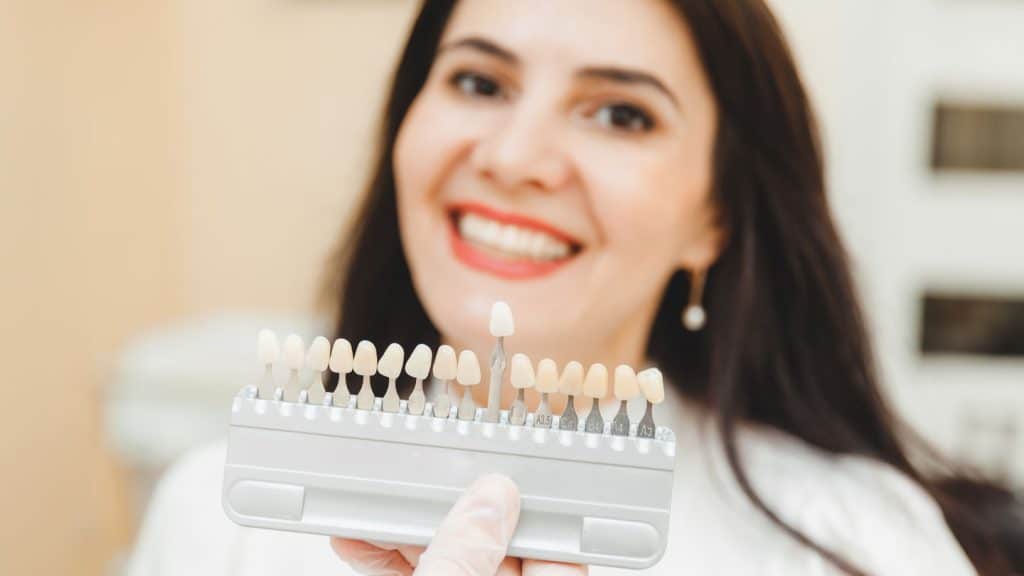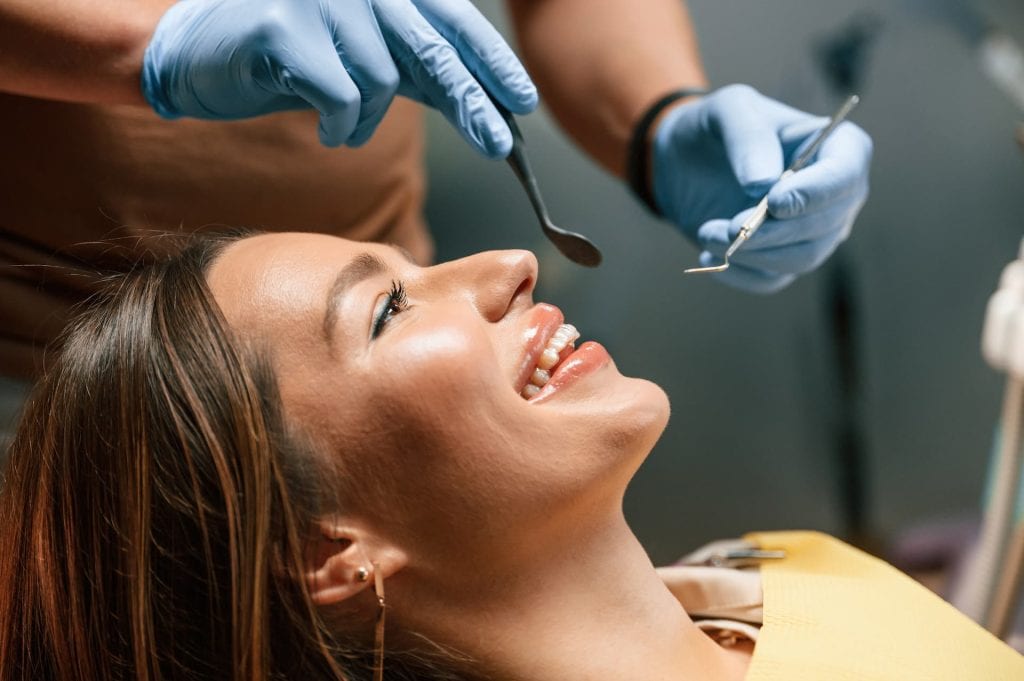Cosmetic Dentistry
Services
Our cosmetic dentistry services are designed to enhance your smile and boost your confidence. From teeth whitening and veneers to complete smile makeovers, we utilize the latest techniques and materials to achieve stunning results. Trust us to transform your smile into one you’ll love to share.
Cosmetic Dentistry at Arden Park Dental
Cosmetic dentistry focuses on improving the appearance of a person’s teeth, gums, and smile. While general dentistry is concerned with the health and function of your teeth, cosmetic dentistry enhances aesthetics, addressing issues such as teeth discoloration, misalignment, chips, cracks, or missing teeth. Cosmetic treatments not only improve your smile but can also boost your confidence and contribute to better oral health.

- Teeth Whitening
- What it is: Teeth whitening is one of the most popular and simplest cosmetic procedures. It involves removing stains and discoloration from the teeth to make them brighter and whiter.
- Methods:
- In-office whitening: This professional treatment, often involving a bleaching gel and light or laser activation, delivers fast and dramatic results.
- Take-home whitening kits: These are custom-made trays filled with whitening gel that you use at home over several days or weeks.
- Ideal for: People with discolored or stained teeth from food, drinks (coffee, wine, tea), tobacco, aging, or certain medications.
- Dental Veneers
- What it is: Veneers are thin shells of porcelain or composite resin that cover the front surface of the teeth to correct imperfections like chips, gaps, stains, or slight misalignment.
- How it works: The dentist prepares the tooth by removing a small amount of enamel, takes an impression of your teeth, and then custom-makes the veneers to fit.
- Ideal for: People with stubborn stains, chipped teeth, or teeth that are slightly misaligned.
- Bonding
- What it is: Dental bonding involves applying a tooth-colored resin material to repair small chips, cracks, or gaps in the teeth. It can also be used to reshape teeth.
- How it works: The resin is applied directly to the tooth, shaped, and then hardened with a special light.
- Ideal for: Minor imperfections such as small chips, gaps between teeth, or areas of decay that need filling.
- Dental Implants
- What it is: Dental implants are artificial tooth roots placed into the jawbone to support replacement teeth or bridges. They offer a long-term solution for missing teeth.
- How it works: An implant is surgically placed into the jawbone, and after healing, a custom-made crown is placed on top. Implants mimic natural teeth in both appearance and function.
- Ideal for: People with one or more missing teeth, as well as those who want a permanent solution that looks and functions like natural teeth.
- Invisalign (Clear Aligners)
- What it is: Invisalign is an orthodontic treatment that uses clear, removable aligners to straighten teeth gradually. Unlike traditional metal braces, Invisalign aligners are virtually invisible and can be removed for eating and cleaning.
- How it works: A series of custom-made aligners are created to fit over your teeth and gently shift them into proper alignment over time.
- Ideal for: Adults and teens who want to straighten their teeth without the appearance of traditional braces. It’s ideal for treating mild to moderate alignment issues.
- Porcelain Crowns
- What it is: A crown is a cap that covers a damaged or decayed tooth. Porcelain crowns are designed to blend seamlessly with natural teeth and restore both the function and appearance of the tooth.
- How it works: The dentist removes the damaged portion of the tooth, takes an impression, and fits a custom-made crown over the remaining tooth structure.
- Ideal for: Restoring teeth that are significantly decayed, cracked, or weakened, as well as improving the appearance of misshapen or discolored teeth.
- Smile Makeovers
- What it is: A smile makeover is a comprehensive treatment plan that combines several cosmetic dental procedures to achieve a dramatic improvement in the appearance of your smile.
- How it works: The dentist evaluates your smile and discusses your goals to design a personalized plan. This may include veneers, whitening, crowns, implants, or other treatments.
- Ideal for: People who want an overall transformation of their smile, addressing multiple cosmetic concerns at once.
- Gum Contouring (Gum Reshaping)
- What it is: Gum contouring is a cosmetic procedure that reshapes the gum line to improve the appearance of your smile. It can correct a “gummy smile” (where too much gum tissue is visible) or uneven gum lines.
- How it works: Using a laser or surgical technique, excess gum tissue is removed or reshaped to reveal more of the teeth.
- Ideal for: People with an uneven gum line, those who feel their gums are too prominent, or those with gum recession that makes teeth appear overly long.
- Orthodontics (Braces)
- What it is: Braces are a traditional method for straightening misaligned teeth and correcting bite issues. While they are more common in younger patients, many adults also opt for braces.
- How it works: Braces consist of metal brackets, wires, and rubber bands that gradually move the teeth into better alignment. Modern alternatives, like ceramic or clear braces, are less noticeable than traditional metal braces.
- Ideal for: Individuals with significant misalignment, bite issues, or crooked teeth who are willing to commit to longer treatment times.
- Tooth Contouring and Reshaping
- What it is: Tooth contouring involves reshaping a tooth by removing small amounts of enamel to improve its size, shape, or length. This is often done in combination with bonding for an enhanced result.
- How it works: The dentist carefully files or sculpts the teeth to create a more uniform appearance.
- Ideal for: People who have teeth with small imperfections (such as chips or uneven edges) that need reshaping or smoothing.
Why Choose Cosmetic Densitry?
Enhanced Aesthetic Appeal
Improved Self-Confidence
Long-Term Results
Functional Benefits
Customized Treatment
Minimally Invasive Options




Healthy Teeth and Gums
While cosmetic procedures focus on aesthetics, your dentist will ensure that your teeth and gums are healthy before proceeding with treatments. Any existing oral health issues (like cavities or gum disease) will be addressed first.
Realistic Expectations
Cosmetic dentistry can do wonders for improving the look of your smile, but it's important to have realistic expectations and understand the limitations of each procedure.
Non-Smokers
Smoking can significantly affect the results of cosmetic treatments, especially whitening and veneers. Non-smokers generally experience better outcomes.
Good Oral Hygiene Habits:
To maintain the results of cosmetic treatments, it's important to practice excellent oral hygiene at home, including brushing, flossing, and regular dental check-ups.
What to Expect During a Costmetic Dentistry Consultation
Initial Evaluation
Treatment Plan
Timeline
Aftercare

Cost of Cosmetic Dentistry
The cost of cosmetic dentistry varies depending on the procedure, complexity of the treatment, and location of the dental practice. Some treatments, like teeth whitening, are relatively inexpensive, while others, like implants or smile makeovers, can be more costly.
- Insurance: Most cosmetic dental procedures are considered elective, meaning they’re not typically covered by dental insurance. However, some treatments that improve function (such as crowns or implants) may be partially covered if they’re deemed medically necessary.
- Payment Options: Many dental offices offer financing options or payment plans to help make cosmetic treatments more affordable.